Croatia's housing market is recovering, along with its economy
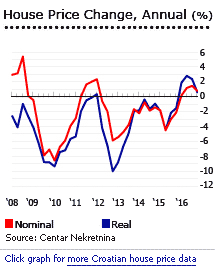 Croatia housing markets are a story of two distinct but not entirely separate markets - local, and foreign. In the coastal areas popular with foreigners, prices continue to rise, while prices of dwellings in the rest of the country mostly continue to suffer.
Croatia housing markets are a story of two distinct but not entirely separate markets - local, and foreign. In the coastal areas popular with foreigners, prices continue to rise, while prices of dwellings in the rest of the country mostly continue to suffer.
Yet since 2015 Croatia's economy has been growing - after a deep recession lasting 6 years - and growth will inevitably strengthen its housing markets. A recovery of prices is already taking place in Zagreb, and the coming years should see a broad local property market recovery.
- The Adriatic coast's house price index rose by 0.9% (0.7% inflation-adjusted) during 2016. This price rise followed annual price y-o-y increases of 1.8% in Q3, 1.9% in Q2, and 0.8% in Q1 2016, based on the figures from the Croatian Bureau of Statistics CBS.
- In Zagreb city house prices, in general, have been rising for the last three quarters. In Q4 2016, house prices in Zagreb city were up by almost 2% y-o-y (1.8% inflation-adjusted), following y-o-y growth of 2.1% in Q3, and 0.1% in Q2 2016. However the average price of new dwellings in Zagreb sharply dropped by 11.5% (-11.6% inflation-adjusted) y-o-y to HRK 10,445 (€1,396.31) per sq. m., suggesting that there is still an overhang of new homes.
- The nationwide house price index for existing dwellings increased by 1.8% y-o-y (1.6% inflation-adjusted) In Q4 2016, while the national house price index for new dwellings dropped by 4.7% y-o-y (-4.9% inflation-adjusted).
Croatia's star property performers are coastal regions like Šibenik-Knin County (4.2% up y-o-y to €1,650 per sq. m.), Istria County (3.13% up y-o-y to €1,577 per sq. m.), and Lika-Senj County (1.94% up y-o-y to €1,169 per sq. m.). The Dalmatian coastal resort town of Split had the highest annual house price growth among Croatia's large cities during the year to January 2017, rising 5.81% to an average apartment price of €2,334 per sq. m., according to the property portal Njuškalo. The most expensive properties can be found in Dubrovnik (€3,349 per sq. m.), followed by the coastal resort town of Opatija (€3,113 per sq. m.) and the tourist island of Hvar (€2,850 per sq. m.).
Međimurje County - the nation's smallest and richest region, which borders Slovenia - is a rare case of inland county that has recorded an annual price recovery, with apartment prices rising by 1.66% y-o-y to an average of €689 per sq. m.
Croatia’s property market has been depressed since the global financial crisis hit the country’s tourism-oriented economy.
- In 2009, the national property price index fell 4.99% y-o-y (-7% inflation-adjusted)
- In 2010, the national property price index fell 6.33% (-7.46% inflation-adjusted)
- In 2011, the national property price index slightly rose 0.18% (-2% inflation-adjusted)
- In 2012, the national property price index fell 1.57% (-5.2% inflation-adjusted)
- In 2013, the national property price index fell 3.95% (-5.65% inflation-adjusted)
- In 2014, the national property price index fell 1.57% (-1.21% inflation-adjusted)
- In 2015, the national property price index fell 2.9% (-2.56% inflation-adjusted)
- In 2016 the property market started to recover, with the national property price index increasing by 0.89% (1.91% inflation-adjusted). Sales totaled around 2,791 dwelling units sold, up from 1,700 units in 2015, according to the Croatian Bureau of Statistics (CBS).
From 2009 to 2014, Croatia's economy lost more than 12% of GDP, Europe’s second-biggest contraction after Greece. The economy contracted in 2009 by 7.4%, in 2010 by 1.7%, in 2011 by 0.3%, in 2012 by 2.2%, in 2013 by 1.1%, and in 2014 by 0.5%, according to the Croatian National Bank (CNB).
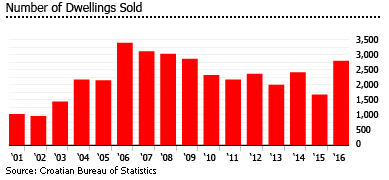
Croatia's economy began to turn around in 2015 and gained momentum in 2016, with estimated growth of 2.9%, according to the Croatian Bureau of Statistics (CBS,. following a 1.6% economic recovery in 2015. During the year to Q4 2016, the economy expanded by 3.4%. The economy is predicted to accelerate further in 2017, according to the CNB and the European Commission (EC). The EC also noted that the government's expansionary fiscal stance will also aid in driving economic growth this year.
In January 1, 2017, Croatia implemented lower real estate transfer tax from 5% to 4%, while on VAT-charged property transactions, the VAT rate remains at 25%. In the second half of the year, the government is expected to subsidize half of first time buyers' loan installments for at least four years.
Croatia’s spectacular coast
About 70,000 foreigners own property in Croatia, mostly on the Adriatic Coast. The Northern peninsula of Istria is home to a property boom fuelled by German buying.
Due to complexities regarding taxation and foreign ownership rules, most bought through a company. However, amendments made to the Croatian Law on Ownership in February 2009 now treat EU nationals as Croatian citizens for the purposes of acquiring real estate in Croatia.
The right of non-EU foreign nationals to buy a property in Croatia depends on reciprocity agreements between Croatia and the foreign buyer’s home country.
Around 55% of approved permits for foreign acquisitions were granted to Germans. Austrians come in second place with 16% of permits granted, followed by Britons (6%), Hungarians (4%) and Dutch (3%).
Of Croatia’s 20 counties (or regions), the five most popular with foreign buyers are on the Adriatic Coast: Istria (33% of foreign-owned properties), Primorje-Gorski Kotar (26%), Split-Dalmatia (12%), Zadar (8%), and Dubrokniv-Neretva (6%). Only 3% of foreign buyers chose Zagreb City.
Continued interest in Croatia’s high-end market
Croatia’s high-end residential market continues to attract foreign buyers. Most of the demand for properties in Istria come from Germans, Austrians, and Slovenians, according to Colliers International. Luxury properties in Dalmatia are popular among foreign buyers from Sweden, Slovakia, and Czech Republic, among others. Some of the second home destinations that are popular among homebuyers include Hvar, Split, and Dubrovnik.
Most of Croatia's high-end property supply are found in Istria, Opatija, Dubrovnik, islands such as Hvar, Brač and Krk, and in tourist resorts. According to Colliers, new retreat resorts are being developed along the Croatian coast, which are expected to increase the supply of luxury residences in the area.
- The Dogus Group's Maraska project in Zadar is expected to add around 115 high-end residences, aside from a hotel and retail segment. The pre-sale of residences will begin in 2017.
- A planned resort at Brizenica Bay, in the island of Hvar, will feature a 120-key Four Seasons hotel and around 60 high-end properties. This resort development from Arqaam Capital and Four Seasons is expected to open in 2019.
Housing supply is rising
After the 2008 crisis, dwelling completions and permits fell even below levels seen during the War of Independence (1991-1995). In 2014, only 7,805 units were completed, and 8,059 units in 2015, according to the Croatian Bureau of Statistics (CBS).
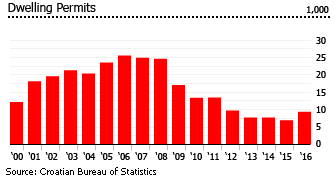
Economic growth is now prompting new demand, and dwelling permits issued in 2016 rose by 35.2% to around 9,398 units.
The mortgage market has been restructured, and there's more domestic currency lending

Croatia's outstanding housing loans contracted massively during the years of decline - in 2012 total housing loans contracted by around 0.8%, in 2013 by 2.8%, in 2014 by 2.4%, in 2015 by 1.7%, and in 2016 by 10.2%, according to the European Central Bank (ECB).
Nevertheless, Croatia’s mortgage market has developed significantly during the past decade. The old large state-owned banks have been privatized, and commercial banks have been restructured. Austrian, Italian and German banks have entered the market. There was a significant increase in building societies’ share of loans, from 1% in 2003 to 5% recently.
One interesting trend has been the rise of kuna-denominated loans in the past two years, according to the CNB. From a share of below 8% of the total outstanding housing loans from 2010 to 2014, the share of kuna-denominated housing loans not indexed to foreign currencies rose to around 20% of the total housing loans by end of 2016. In February 2017, most new housing loans were kuna-denominated - amounting to HRK 354.28 million (€ 47.43 million) - while foreign currency-indexed kuna loans were relatively lower at HRK 285.15 million (€38.17 million), a reverse from a year ago wherein most housing loans were indexed to a foreign currency.
According to Igor Ljubaj and Suzana Petrović of the CNB the rise of kuna loans was due to:
- The decline of interest rates on kuna loans as a result of the drop in the general level of interest rates;
- Households' negative experience with Swiss franc-indexed loans
- CNB's expansionary monetary measures and regulatory changes that raised the consumers' awareness about currency risk;
- Strong competition among banks in granting new loans, amid generally subdued lending activity; and
- Banks' reduced reliance on foreign currency financing
Mortgage interest rates continue to fall
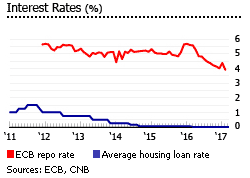
Rates for housing loans indexed to foreign currency have continued to fall, standing in February 2017 at:
- Floating rate and interest rate fixation (IRF) of up to 1 year: 4.20%, down from 5.74% a year earlier.
- IRF over 1 and up to 5 years: 3.34%, also a decline from 4.53% a year earlier.
- IRF over 5 years and up to 10 years: 3.86%, lower than last year's 4.71%.
- IRF over 10 years: 4.09%, down from 5.23% a year earlier.
Rates for housing loans not indexed to foreign currency have also fallen:
- Floating rate and IRF of up to 1 year: 4.35%, a decline from 4.98% a year earlier.
- IRF over 1 and up to 5 years: 4.60%, down from last year's 4.91%.
- IRF over 5 years and up to 10 years: 4.52%, a drop from 5.06% in the previous year.
- IRF over 10 years: 4.66%, down from 5.09% a year earlier.
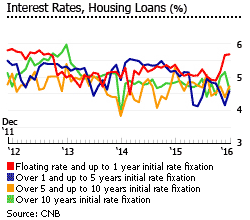
Around 30% of all new housing loans had floating rate or with interest rate fixation (IRF) of up to 1 year. In contrast, about 20% of all new housing loans have an IRF of more than 10 years.
Rental yields are moderate; small rental market
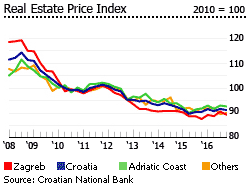
Most Croatians are owner-occupiers. In 2015, around 90.5% of the country's total households were living in an owner-occupied home or apartment, according to the Eurostat. The rental market concentrates on short-term holiday rentals for foreigners and tourists, with good resort waterfront real estate on Adriatic coast fuelling demand.
Yet some long-term rental market does exist, and gross rental yields on long-term lets in Croatia's capital, Zagreb, are moderate to good, ranging from 5.63% to 6.23%, based on the Global Property Guide research in September 2016. There is no particular connection between size of apartment and yields.
Most long-term rental properties are in Zagreb, Dubronik, and Split. In Zagreb, the demand for rental properties partly comes from students studying at the University of Zagreb, as in Split, where the greatest demand is in the city centre and around the university campus.
An average rent for a 50-sq. m. apartment in Zagreb was at HRK 2,016.79 (€270) per month, while a 120 sq. m. apartment can be rented at HRK 4,422.01 (€592) per month, according to the Global Property Guide research in September 2016.
Economic growth expected to continue in 2017

During the year to Q4 2016, the economy expanded by 3.4%. The Croatian economy is predicted to accelerate further in 2017, according to the CNB and the European Commission (EC). The EC also noted that the government's expansionary fiscal stance will also aid in driving economic growth this year.
Croatia’s most serious problem is high unemployment, the fourth highest in the EU, following Greece, Spain and Cyprus. However, the numbers have substantially dropped, according to the Eurostat. Based on Eurostat's data, Croatia is one of the EU member countries with the largest unemployment declines in February 2017. In March 2017, unemployment rate was at 14.4%, down from 17.2% in the previous year, according to the CBS.
In March 2017, Croatia's annual inflation stood at 1.1%, according to the CNB, after rates of -1.1% in 2016, -0.5% in 2015, and -0.2% in 2014. The CNB expects the inflation to rise to 1.6% in 2017, mainly due to the inflationary pressures of imported goods, as well as the expected rise in the prices of crude oil and raw materials.
New government after 2016 snap elections

In a parliamentary election held on September 11, 2016, the conservative party Croatian Democratic Union (HDZ) was victorious, winning 61 seats, still below the 76 seats needed for a parliamentary majority. The Social Democratic Party (SDP), the leading centre-left party and HDZ's rival, came second and won 54 seats.
HDZ leader, Andrej Plenković, assumed office as the country's new Prime Minister in October 2016, succeeding Tihomir Orešković, who served as Croatia's Prime Minister for only less than a year. Prime Minister Plenković has promised a "Europe-oriented" government, and formed a coalition with the Bridge of Independent Lists (MOST) in October 2016.
In March 2016, Moody’s Investors Service downgraded Croatia’s credit rating from Ba1 to Ba2, with negative outlook. Moody's negative outlook was revised to stable in March 2017, due to a reversal in the upward trajectory of public sector debt, and stronger economic growth.
Unlike other new European Union members, which experienced an economic boost after their accession, Croatia joined the EU on July 1, 2013 when the EU was struggling. Since the beginning of 2014, Croatia has been in the European Commission’s Excessive Deficit Procedure (EDP) due to its high budget deficits and public debt. But the country’s budget deficit was cut to 1.8% of GDP in 2016, down from 3.3% of GDP in 2015, and 5.4% of GDP in 2014, according to the European Commission. The country’s public debt was 84.1% of GDP in 2016, down from 86.7% of GDP in 2015. In 2017, Croatia's budget deficit is expected to rise again to 2.1% of GDP due to the new government's tax reforms, but is expected to drop again to 1.8% of GDP in 2018.